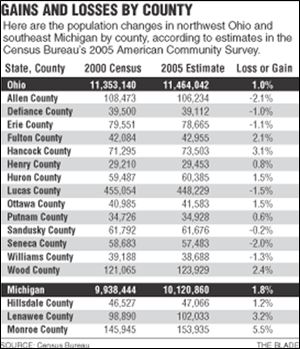
Population of Toledo dips below 300,000
8/16/2006

A gallon of milk cost 34 cents, gasoline cost 18 cents a gallon, and the average annual household income was $1,900 in 1940 - the last time Toledo's population was under 300,000 people.
For the first time in more than 60 years, Toledo's population has dipped to 285,937, according to an estimate in the 2005 American Community Survey announced yesterday by the U.S. Census Bureau. Even allowing for the survey's stated margin of error, the city's population would still not exceed 292,000.
Toledo suffered a loss of 27,682 people or 8.8 percent between 2005 and the last official Census Bureau count in 2000, when the city's population was recorded at 313,619, the survey reported.

Akron, Columbus, Cleveland, Cincinnati, and Dayton also suffered population losses in the latest American Community Survey estimates.
The survey was started by the Census in 1996 to provide states, counties, and communities with updated estimates about how they are changing between 10-year official counts. About 3 million households nationwide are surveyed each year to produce the estimates, which only covers communities and counties in Ohio of at least 55,000 people.
Lucas County, which includes Toledo, has had a 1.5 percent population decline since 2000, from 455,054 residents to 448,229. During that same time, every bordering county in northwest Ohio and southeast Michigan had population gains.

The region's biggest population gains continue to be in Monroe County, which has had a 5.5 percent increase in residents since 2000. At nearly 154,000 people in the 2005 estimate, Monroe is the region's largest county outside of Lucas. Wood County is estimated at third with nearly 124,000 residents as of last year. Much of that growth was in the northern communities where many residents commute to work in Toledo and Lucas County.
In Monroe County, the gains have largely been at the extreme north and south ends of the county, mostly from people fleeing the urban counties of Wayne County and Lucas County.
"We are disappointed to see the drop in the city's population, but we are not the only ones," Brian Schwartz, spokesman for Toledo Mayor Carty Finkbeiner, said of the latest Census survey results. "This is a problem for all the major Ohio cities."
In fact, Toledo's population change from 2000 to 2005 is in the middle of the Buckeye state's major urban centers, which ranged from a decline of 2.5 percent in Columbus to more than 20 percent in Dayton.

"If you look at the numbers, you can see we are very close to passing Cincinnati in size," Mr. Schwartz said, attempting to put a positive spin on a decline in population in Toledo that has continued since a peak of 383,318 people in 1970.
Claiming Toledo and Lucas County are in the process of an economic recovery that will lure people back, Mr. Schwartz and county Commissioner Pete Gerken pointed to the proposed Marina District and arena projects as catalysts for turnaround.
"We have now hit the bottom and things are going to start changing," Mr. Gerken said.
But the economic prosperity that might have attracted people into the city at its population peak 35 years ago is nothing but a memory, said Fred Folger, a Toledo historian who has studied the city's economic and population trends.
"It seems to me to be fairly obvious. We have lost a number of our major companies in Toledo in the last few decades, and the people went with them," he said. "We lost many of the manufacturers that were the base of good, solid jobs for many people."
Mr. Folger said the growth of suburbs and the recent phenomenon of "exurbs" expanding beyond suburbs into rural areas "happened at the expense of the core city and it is happening in other cities in Ohio and across the country."
"Cleveland, Cincinnati, and Dayton are all in the same boat," he said, agreeing with Mr. Schwartz on that point.
At least one official contacted by The Blade, Toledo Council President Rob Ludeman, questioned the accuracy of the Census estimate for the city. As a Realtor, he said he thinks he would have noticed an exodus of more than 27,000 people from the city since 2000.
"That would have left gaping holes in parts of the city and I haven't seen it," Mr. Ludeman said. "I'd have to see their data and how they came up with that. It just doesn't seem right to me."
Monroe County Commissioner David Scott, meanwhile, was pleased with the estimates of population gains for his county. He cited Michigan's lower property taxes and the shift in school funding to a sales tax-based model as key among the reasons his county continues to grow.
"That was an incentive for many people from Ohio to move to Michigan, even though many of them still work outside Monroe County and the state," said Mr. Scott, a 10-year member of the county board of commissioners.
But Mr. Scott acknowledged that with population gains come growing pains: the need for water and sewer line extensions and improvements to roads that now serve growing subdivisions.
"We're growing too fast and our infrastructure is hurting because of it," he said.
Blade Staff Writer Tom Troy contributed to this report
Contact Karamagi Rujumba at:
krujumba@theblade.com,
or 419-724-6064.